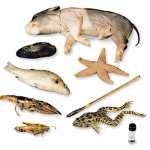Zoology
|
26 november 2015 19:20:17 |
| Genome-wide association study reveals a locus for nasal carriage of Staphylococcus aureus in Danish crossbred pigs (BMC Veterinary Research) |
|
Tweet Background:
Staphylococcus aureus is an important human opportunistic pathogen residing on skin and mucosae of healthy people. Pigs have been identified as a source of human colonization and infection with methicillin-resistant Staphylococcus aureus (MRSA) and novel measures are needed to control zoonotic transmission. A recent longitudinal study indicated that a minority of pigs characterized by high nasal load and stable carriage may be responsible for the maintenance of S. aureus within farms. The primary objective of the present study was to detect genetic loci associated with nasal carriage of S. aureus in Danish crossbred pigs (Danish Landrace/Yorkshire/Duroc).
Results:
Fifty-six persistent carriers and 65 non-carriers selected from 15 farms surveyed in the previous longitudinal study were genotyped using Illumina’s Porcine SNP60 beadchip. In addition, spa typing was performed on 126 S. aureus isolates from 37 pigs to investigate possible relationships between host and S. aureus genotypes. A single SNP (MARC0099960) on chromosome 12 was found to be associated with nasal carriage of S. aureus at a genome-wide level after permutation testing (p = 0.0497) whereas the association of a neighboring SNP was found to be borderline (p = 0.114). Typing of S. aureus isolates led to detection of 11 spa types belonging to the three main S. aureus clonal complexes (CC) previously described in pigs (CC9, CC30 and CC398). Individual carriers often harbored multiple S. aureus genotypes and the host-pathogen interaction seems to be independent of S. aureus genotype.
Conclusion:
Our results suggest it may be possible to select pigs genetically resistant to S. aureus nasal colonization as a tool to control transmission of livestock-associated MRSA to humans. |
| 125 viewsCategory: Medicine, Zoology |
 Parasitic fauna of domestic cavies in the western highlands of Cameroon (Central Africa) (BMC Veterinary Research) Parasitic fauna of domestic cavies in the western highlands of Cameroon (Central Africa) (BMC Veterinary Research)Heat stress related dairy cow mortality during heat waves and control periods in rural Southern Ontario from 2010–2012 (BMC Veterinary Research) 
|
| blog comments powered by Disqus |
MyJournals.org
The latest issues of all your favorite science journals on one page
The latest issues of all your favorite science journals on one page



